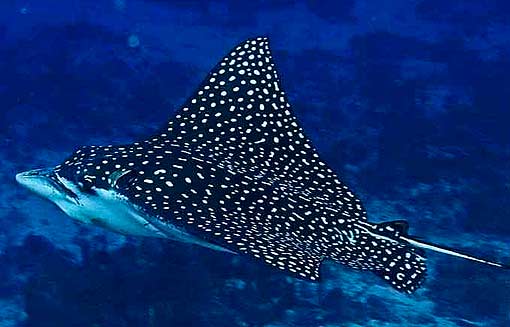Step One: Identifying a Ray
Luckily, rays are very simple to identify. All rays are flat
creature that have two large pectoral fins that are fused with the entire body
giving the ray an almost diamond, round, or triangular shape. The pectoral fins
move gracefully in a wing-like motion to propel this creature forward. Another
defining characteristic of a stingray is its long, whip-like tail that extends
out of the anterior side of the ray. All rays range in size from several inches
to several feet and there be over 500 species of rays. So congratulations, you
can now narrow down your search for the Spotted Eagle Ray to about 500 species!
Step Two: Distinguishing Between the Sting Ray, Manta Ray, and Skate.
Stingrays are easily identified by their diamond shape and
long tail with barbed stings that can inject poison into a threat when it feels
disturbed. Sting Rays are also mostly found at the bottom of the ocean or buried
in the sand for camouflage. Manta Rays are generally very, very large! Manta
Rays can grow up to 3,000 pounds with a wingspan of up to 25 feet! Lastly,
Manta Rays do not have barbed stings thanks to thousands of years of evolution.
Skate are similar to sting rays, but they do not have barbs on their tails. The
barbs are located along the spine of the fish and the tail is much thicker than
that of a sting ray. Skates also have a rounded shape and an elongated nose.
Now that you can distinguish between rays, though process of elimination you
can now narrow down your search!

Step Three: Identifying the Spotted Eagle Ray
Congratulations, you made it! It’s time to learn the basic
characteristics that will help you identify the Spotted Eagle Ray! This Ray,
also known as the Bonnet Ray, is a very beautiful creature and is one ray that
can actually be found higher in the water column unlike its cousins. These rays
are a navy blue color and are spotted with hundreds of white, star-shaped spots.
Spotted Eagle Rays can grow up to 16 feet long, eight feet wide, and weigh up
to 500 pounds! This is all you need to know when identifying a Spotted Eagle
Ray because they are truly one of a kind! If you are lucky enough, you can spot
these beautiful rays gliding across the water in large schools or even jumping
out of the water. Get your camera ready, because you now know how to identify
the amazing Spotted Eagle Ray.

More about the Spotted Eagle Ray
No comments:
Post a Comment
Note: Only a member of this blog may post a comment.